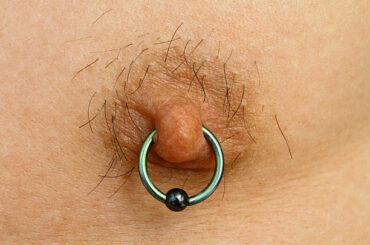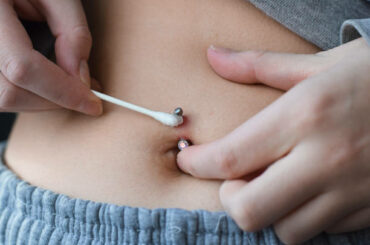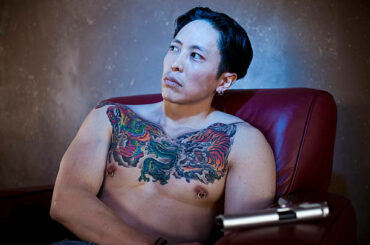Conch Piercing. In the vast realm of ear piercings, the conch piercing stands out as a captivating blend of tradition and trendiness. Situated in the cartilage’s inner or outer region, resembling the spiral of a conch shell, this piercing has become more than just an aesthetic choice; it’s a style statement. Over the recent years, there’s been a noticeable uptick in its allure, making the conch piercing a sought-after modification in the ever-evolving world of ear adornments. As people continuously search for unique ways to express themselves, the rising popularity of the conch piercing is a testament to its distinctive charm and modern appeal.
Contents
What is a Conch Piercing?
A conch piercing is a type of ear modification that involves perforating the ear’s cartilaginous area. Specifically, it is located within the largest concave structure of the external ear, aptly named because of its strong resemblance to the spiral shape of a conch shell. But not all conch piercings are created equal; there are two distinct types to consider.
The inner conch piercing is situated in the ear cartilage’s central part, close to the ear canal. It’s nestled within the bowl-shaped area, giving it a somewhat hidden yet intriguing appeal when adorned with jewelry.
On the other hand, the outer conch piercing is positioned on the flat cartilage part, adjacent to the ear’s outer ridge. This location offers more pronounced visibility, allowing wearers to showcase more prominent or decorative jewelry pieces.
Both variations of the conch piercing offer unique aesthetics, but the choice between inner and outer often comes down to personal preference and desired jewelry style. Whether subtly tucked away or prominently displayed, the conch piercing stands as a testament to the versatility and innovation found in contemporary piercing artistry.

History and Origin of the Conch Piercing
The journey of the conch piercing is as intriguing as its aesthetic appeal. While many contemporary body modifications have ancient roots, the conch piercing’s history is somewhat more modern, with its mainstream popularity surging mainly in the late 20th and early 21st centuries. However, the fascination with ear cartilage adornment is not entirely new.
Historically, ear piercings have been present across various cultures for millennia, often signifying tribal affiliations, rites of passage, or societal status. While there isn’t substantial evidence pointing to ancient civilizations specifically adorning the conch area, various indigenous groups have experimented with cartilage piercings, suggesting that the conch, in its essence, might not be an entirely modern innovation.
As for cultural significance, the conch piercing doesn’t seem to have the deep-rooted symbolic importance that some other body modifications possess. In modern times, its adoption can be traced back to the broader body art movement, where boundaries were pushed, and unconventional piercings became more commonplace. The rise of punk culture in the 70s and 80s also saw a surge in non-traditional piercings, with the conch piercing gaining traction in such circles.
Today, while the conch piercing doesn’t hold a specific cultural meaning in most societies, it serves as a symbol of individual expression, personal style, and the ever-evolving landscape of body art.
Why is the Conch Piercing So Popular? So, Conch Piercing
The conch piercing has steadily carved its niche in the world of body art, winning admirers from all walks of life. But what has catapulted this once-understated piercing to the forefront of modern style statements?
- Aesthetic Appeal: At its core, the conch piercing is visually stunning. Whether nestled within the ear’s curves or gracing its outer ridge, it adds a touch of elegance and intrigue. Unlike the typical lobe piercing, the conch offers a canvas that marries the ear’s natural curves with jewelry, creating a harmonious blend of anatomy and artistry.
- Versatility in Jewelry Choices: One of the standout features of the conch piercing is its adaptability to various jewelry types. From subtle studs that offer a hint of sparkle to intricate hoops and barbells that loop through the cartilage, there’s no shortage of ways to adorn a conch piercing. This versatility ensures that wearers can frequently update their look, making the conch a favorite for those who enjoy experimenting with different jewelry styles.
- Uniqueness Compared to Other Piercings: While earlobes and helix piercings have been widely embraced for decades, the conch piercing brings a fresh perspective to ear adornments. Its positioning — either hidden within or proudly on the ear’s outer cartilage — sets it apart from more traditional piercings. This distinction means wearers can enjoy a sense of individuality, even in spaces where piercings are commonplace.
The Process of Getting a Conch Piercing
Opting for a conch piercing is more than just a spur-of-the-moment decision. It’s a journey that requires careful planning, a touch of courage, and an understanding of what the procedure entails. Here’s a breakdown of the process:

- Pre-piercing Considerations:
- Choosing the Right Piercer: Your first step is to research and identify a reputable piercer. Look for someone with a solid track record, positive reviews, and a clean, professional environment. A seasoned piercer will not only ensure the process goes smoothly but can also offer invaluable advice on aftercare and jewelry selection.
- Preparing Mentally: Like any other body modification, a conch piercing can cause anxiety, especially for first-timers. It’s essential to understand why you want the piercing and to be mentally prepared for the experience.
- Preparing Physically: It’s recommended to get a good night’s sleep before the piercing day and eat a balanced meal to maintain blood sugar levels. Avoiding alcohol or drugs before the procedure can also prevent unnecessary bleeding and help with healing.
- The Actual Piercing Procedure:
- Once you’re in the piercing studio, the piercer will start by cleaning the ear thoroughly.
- The piercer will mark the exact spot where the piercing will be made. This is your chance to confirm the positioning.
- Using a sterilized needle, the piercer will perform the piercing. For conch piercings, a hollow needle is typically used to create a clean puncture.
- After the piercing, jewelry is inserted, and the area is cleaned once more.
- Pain Scale: What to Expect:
- However, compared to softer parts like the earlobe, cartilage piercings like the conch can be more uncomfortable.
- Most individuals describe the sensation as a sharp pinch followed by a dull, throbbing ache. It’s over relatively quickly.
- After the piercing, it’s natural for the area to be tender and swollen for several days. It’s essential to be prepared for this discomfort and follow aftercare instructions diligently.
Aftercare and Healing for the Conch Piercing
A conch piercing, with its distinctive position and appeal, is undoubtedly a style statement. However, like all piercings, its beauty and longevity greatly depend on proper aftercare. Ensuring that the pierced area remains clean and free from complications is crucial. Here’s a detailed look into the aftercare and healing process:
- Importance of Proper Aftercare:
- Prevention of Infections: Any new piercing is essentially a wound, and like all wounds, it’s susceptible to infections. Proper aftercare ensures that the area remains clean, reducing the chances of bacterial buildup.
- Aesthetics and Longevity: For the piercing to look its best and to allow for a diverse range of jewelry in the future, it has to heal correctly without complications.
- Recommended Cleaning Procedures:
- Saline Solution: Using a saline solution (salt water) is the most recommended method. Gently cleaning the pierced area with a saline-soaked cotton ball or pad twice a day can help remove debris and promote healing.
- Avoid Over-Cleaning: While it’s crucial to keep the area clean, over-cleaning can irritate the skin and delay healing. Stick to cleaning 1-2 times a day.
- Avoid Touching with Dirty Hands: Always ensure your hands are clean if you need to touch the piercing. However, it’s best to avoid unnecessary touching altogether.
- Potential Complications and How to Handle Them:
- Infections: Symptoms may include persistent redness, warmth, unusual discharge, or swelling. If you suspect an infection, it’s essential to see a healthcare professional and avoid removing the jewelry, as this can trap the infection inside.
- Migration or Rejection: Sometimes the body may try to push the jewelry out, causing it to move or, in rare cases, reject it entirely. If you notice significant movement, consult with your piercer.
- Keloids or Bumps: Some people might develop small bumps or keloids around the piercing. Treatments vary, but saline soaks and avoiding trauma to the area can help. For persistent issues, consulting a dermatologist is advisable.
- Expected Healing Time:
- Initial Healing: The initial healing phase, where the piercing is most vulnerable and might appear swollen or red, can last anywhere from a few weeks to a couple of months.
- Complete Healing: For the cartilage to fully heal and for the piercing channel to mature, it can take anywhere from 6 months to a year or even longer for some individuals.

Jewelry Options for the Conch Piercing
Choosing the perfect adornment for your conch piercing is akin to selecting the ideal accessory for an outfit – it defines style, makes a statement, and showcases personality. With the conch piercing’s growing popularity, there’s an array of jewelry options available to suit every taste. Let’s delve into the exciting world of conch jewelry:
- Popular Jewelry Types for the Conch Piercing:
- Studs: One of the go-to choices, especially for new piercings, studs are subtle yet can carry a lot of charm, especially when adorned with gemstones or unique designs.
- Hoops or Rings: These wrap around the conch, offering a pronounced look. They can be simple or embellished with beads or dangles.
- Barbells: Typically more suited for the outer conch, barbells can be straight or curved, often with decorative ends.
- Captive Bead Rings (CBRs): A ring with a small bead that clasps in place, this option offers a blend of subtlety and style.
- How to Choose the Right Size and Material:
- Size: The size of the jewelry largely depends on the anatomy of one’s ear and the exact placement of the piercing. Initially, slightly longer jewelry might be used to accommodate swelling. Your piercer will guide you on the best size during the healing phase and once the piercing has healed.
- Material: Hypoallergenic materials like surgical steel, titanium, niobium, and gold (14k or higher) are recommended, especially for fresh piercings, to avoid allergic reactions or complications.
- Styling Tips for Showcasing the Piercing:
- Layered Look: For those with multiple ear piercings, consider coordinating metals or gemstone colors for a cohesive look. A delicate gold hoop in the conch paired with gold studs in the lobe can be striking.
- Statement Pieces: For a standout effect, choose a larger hoop with intricate designs or a stud with a prominent gemstone.
- Minimalist Approach: For a more understated look, a simple, thin hoop or a petite stud can be both elegant and understated.
- Seasonal Flair: Consider changing jewelry based on the season or occasion. Festive colors for holidays or dainty floral designs for spring can keep your look fresh and exciting.
Conclusion
The conch piercing stands out as a fusion of traditional ear adornments and modern style, captivating enthusiasts with its unique positioning and versatile styling potential. Beyond its undeniable allure, it brings with it certain considerations, from the initial decision-making process and piercing procedure to diligent aftercare and jewelry selection. Each step in the conch piercing journey is vital in ensuring its beauty and longevity. For those enamored by its charm and contemplating this piercing, the journey is both personal and artistic. It’s essential to remember that professional guidance is invaluable. Seeking advice from reputable piercers, who can offer insights based on experience and expertise, will ensure that your conch piercing not only looks exceptional but also heals perfectly. In the world of body art, where expression meets aesthetics, the conch piercing undoubtedly holds a special place. If it calls out to you, take that leap, but do so with the right knowledge and expert guidance by your side.





